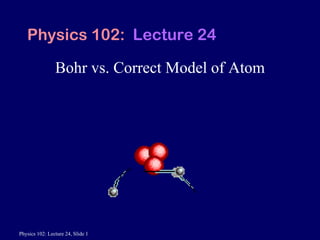Report
Share

Recommended
More Related Content
What's hot
What's hot (20)
IB Chemistry on Quantum Numbers, Electronic Configuration and De Broglie Wave...

IB Chemistry on Quantum Numbers, Electronic Configuration and De Broglie Wave...
12th Physics - Atoms Molecules and Nuclei for JEE Main 2014

12th Physics - Atoms Molecules and Nuclei for JEE Main 2014
IB Chemistry on Quantum Numbers, Electronic Configuration and De Broglie Wave...

IB Chemistry on Quantum Numbers, Electronic Configuration and De Broglie Wave...
How the Bohr Model of the Atom Accounts for Limitations with Classical Mechan...

How the Bohr Model of the Atom Accounts for Limitations with Classical Mechan...
Similar to Lect24 handout
Similar to Lect24 handout (20)
More from oyunbileg06
More from oyunbileg06 (20)
Recently uploaded
Recently uploaded (20)
EMPOWERMENT TECHNOLOGY GRADE 11 QUARTER 2 REVIEWER

EMPOWERMENT TECHNOLOGY GRADE 11 QUARTER 2 REVIEWER
Navi Mumbai Call Girls 🥰 8617370543 Service Offer VIP Hot Model

Navi Mumbai Call Girls 🥰 8617370543 Service Offer VIP Hot Model
Emergent Methods: Multi-lingual narrative tracking in the news - real-time ex...

Emergent Methods: Multi-lingual narrative tracking in the news - real-time ex...
Apidays Singapore 2024 - Scalable LLM APIs for AI and Generative AI Applicati...

Apidays Singapore 2024 - Scalable LLM APIs for AI and Generative AI Applicati...
Connector Corner: Accelerate revenue generation using UiPath API-centric busi...

Connector Corner: Accelerate revenue generation using UiPath API-centric busi...
Apidays Singapore 2024 - Building Digital Trust in a Digital Economy by Veron...

Apidays Singapore 2024 - Building Digital Trust in a Digital Economy by Veron...
Exploring the Future Potential of AI-Enabled Smartphone Processors

Exploring the Future Potential of AI-Enabled Smartphone Processors
Apidays New York 2024 - The Good, the Bad and the Governed by David O'Neill, ...

Apidays New York 2024 - The Good, the Bad and the Governed by David O'Neill, ...
Boost Fertility New Invention Ups Success Rates.pdf

Boost Fertility New Invention Ups Success Rates.pdf
Automating Google Workspace (GWS) & more with Apps Script

Automating Google Workspace (GWS) & more with Apps Script
Axa Assurance Maroc - Insurer Innovation Award 2024

Axa Assurance Maroc - Insurer Innovation Award 2024
Cloud Frontiers: A Deep Dive into Serverless Spatial Data and FME

Cloud Frontiers: A Deep Dive into Serverless Spatial Data and FME
Lect24 handout
- 1. Bohr vs. Correct Model of Atom Physics 102: Lecture 24
- 3. Rutherford Scattering Scattering He ++ atoms off of gold. Mostly go through, some scattered back! Atom is mostly empty space with a small (r = 10 -15 m) positively charged nucleus surrounded by cloud of electrons (r = 10 -10 m) Plum pudding theory: + and – charges uniformly distributed electric field felt by alpha never gets too large To scatter at large angles, need positive charge concentrated in small region (the nucleus) + (Alpha particles = He ++ )
- 4. Nuclear Atom (Rutherford) Classic nuclear atom is not stable! Electrons will radiate and spiral into nucleus Need quantum theory Large angle scatterings nuclear atom
- 7. Hydrogen-Like Atoms nucleus with charge +Ze (Z protons) single electron with charge -e e = 1.6 x 10 -19 C Ex: H (Z=1), He + (Z=2), Li ++ (Z=3), etc
- 8. The Bohr Model Electrons circle the nucleus in orbits Only certain orbits are allowed 2 π r = n λ = nh/p pr = nh/2 π Angular momentum is quantized -e +Ze L = Energy is quantized
- 17. Demo: Line Spectra In addition to the continuous blackbody spectrum, elements emit a discrete set of wavelengths which show up as lines in a diffraction grating. Better yet… Wavelengths can be predicted! This is how neon signs work! n=3 n=1
- 18. ACT/Preflight 24.3 Electron A falls from energy level n=2 to energy level n=1 (ground state), causing a photon to be emitted. Electron B falls from energy level n=3 to energy level n=1 (ground state), causing a photon to be emitted. Which photon has more energy? 1) Photon A 2) Photon B n=2 n=3 n=1
- 19. Spectral Line Wavelengths Calculate the wavelength of photon emitted when an electron in the hydrogen atom drops from the n=2 state to the ground state (n=1). E 1 = -13.6 eV E 2 = -3.4 eV Example n=2 n=3 n=1
- 20. ACT: Spectral Line Wavelengths Compare the wavelength of a photon produced from a transition from n=3 to n=2 with that of a photon produced from a transition n=2 to n=1. 32 < 21 32 = 21 32 > 21 n=2 n=3 n=1
- 22. Preflights 24.6, 24.8 So what keeps the electron from “sticking” to the nucleus? Centripetal Acceleration Pauli Exclusion Principle Heisenberg Uncertainty Principle To be consistent with the Heisenberg Uncertainty Principle, which of these properties cannot be quantized (have the exact value known)? (more than one answer can be correct) Electron Radius Electron Energy Electron Velocity Electron Angular Momentum
Editor's Notes
- 1
- Fundamental assumption of Bohr model: atomic levels are quantized
- ).
- Mention: Quantized energy means particle cannot be anywhere in the hole but only at discrete heights (or energy levels).
- check numerology: 511000/(2*137*137)=13.6 eV 1240 *137/(2*pi*511000)=0.0529 nm
- Again, basically guessed on this one. Might do it as an ACT
- greater attraction, smaller radius, more binding This is doubly ionized Li
- http://www.colorado.edu/physics/2000/quantumzone/bohr2.html
- Demo with neon, Hg, H, He discharges and diffraction grating
- 78% right
- 39% got this correct.
- Compare states with seats in auditorium n=row, l=seat ml=??? Ms=male/female